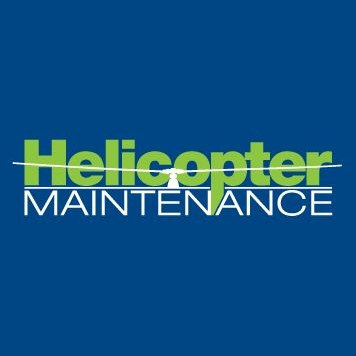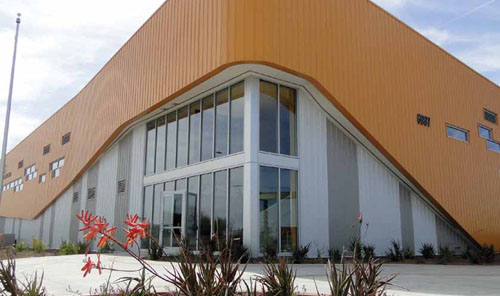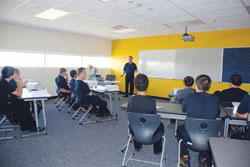
Western Maricopa Education Center (West-MEC) Aviation Technology Program


R. Fred Polak | Editor
West-MEC is a public school district within Arizona’s Marciopa county. It has its own superintendent, support staff and seven-member governing board. The district covers 4,254 square miles and serves more than 26,000 students from 40 high schools. According to Gregory J. Donovan, superintendent of West-MEC, “West-MEC focuses solely on Career and Technical Education (CTE) programs that prepare students to enter the workforce and pursue continuing education. Our unique school district offers students the opportunity to choose a variety of career-related courses on their high school campuses. We also offer central programs, which are located at learning sites supported by business, industry and post-secondary institutions.”
West-MEC is one of 13 joint technological education districts (JTEDs) preparing students for future careers throughout Arizona. Along with the state’s universities, community colleges, and primary and secondary schools, JTEDs are one of the four legs of Arizona’s educational system.
The Aviation Technology Program is offered to eligible high school juniors and seniors and covers 1,952 hours of instruction. Certification is done by the FAA and earns the student 12 credit hours toward his or her high school diploma. When successfully completing the course, the student is ready to take the FAA A&P licensing exam. The following is an interview I conducted with Cliff Migal, assistant to the superintendent.
HeliMx: What led West-MEC to decide to offer aviation maintenance training to begin with?
Migal: In the very beginning when the district was being formed, we started our relationship with business and industry to keep us abreast of the most current curriculum technologies, operations, etc.
We had an advisory commission and began to do occupational research and broke that down into broad categories like transportation, manufacturing, health, marketing, IT and business. We highlighted some occupational areas in each of those fields that we needed to pursue based on what our research found. In the greater Phoenix area in terms of occupational needs, aviation was one area we looked at and saw that the need was there. We formed an aviation advisory committee and brought a group together that was representative of the aviation industry. It started with seven to eight people and they started to ask questions. What should we do and what should we emphasize? That led to where we are today. They helped to design the direction of the program, the curriculum and what the facilities should look like, how it should function and the audience we should pursue first, second and third.
HeliMx: What does the time line look like?
Migal: Our instructors came on board in early May. Construction of the hangar and training classrooms was completed and ready for FAA approval in June. The A&P Program launched Aug. 8, 2011. Our initial capacity is 50 students and we currently have 46 students enrolled in the course.


HeliMx: What are your next steps?
Migal: At this site, we’re looking to add air traffic control, avionics and world of manufacturing engineering.
HeliMx: Who are the major business partners helping you?
Migal: U.S. Airways, Southwest Airlines and Honeywell International, to name a few. We are always looking to expand our partner base. We are also looking to partner with Luke AFB, Sky Harbor Airport operations, the City of Glendale Airport Administration and the Glendale Pilots Association.

HeliMx: Are you looking to expand to other counties?
Migal: For now, we will stay within the confines of the West-MEC region. We are working to get advice and input and acquisitions with Honeywell, Av Air, Rolls-Royce and others.
HeliMx: What is your maximum capacity as far as the number of students that can go through the program at a given time?
Migal: Capacity will ultimately be 150 students at any time, 100 high school students and 50 adults. The FAA regulations certify that for us to have 100 students enrolled, all instructional staff must be on board. Initially we are certified for 50 students and that gives us time to grow our staff. We are looking to reach our full capacity by August 2013.
HeliMx: This is great for those looking to get their A&P ticket right out of high school. Are you looking to add any other courses down the road?
Migal: Probably some stand-alone avionics courses, as there is a need for that also.
HeliMx: I suppose that most of the A&P course revolves around fixed-wing aircraft?
Migal: It does, but we are looking at getting some helicopter training in house also. This would be maintenance training. We do not offer flight training in any form.
HeliMx: The facility adjacent to the Glendale Municipal Airport includes a hangar, seven classrooms, and training labs, meeting space, a library, a computer lab and offices. Any more growth going to happen soon?
Migal: We are doing due diligence on 10-12 acres of property, about 78,000 square feet of building space at Deer Valley Airport in North Phoenix. That includes an 8,000-square-foot hangar with private taxiway. We would be able to do some other things at that facility.
HeliMx: What might those other things be?
Migal: Possibly something to do with air traffic controller training and some avionics classes. Our advisory committee is looking into these areas.
With the aviation industry in dire need of licensed A&P mechanics, West-MEC is a great way for high school students interested in working in the aviation industry to get the jump on getting the required training early on. West-MEC has distinguished itself as an innovative leader attuned to workforce needs, working in partnership with business and industry. State-of-the-art equipment, unique programs and dedicated instructors combine to give students a learning pathway for future success.
